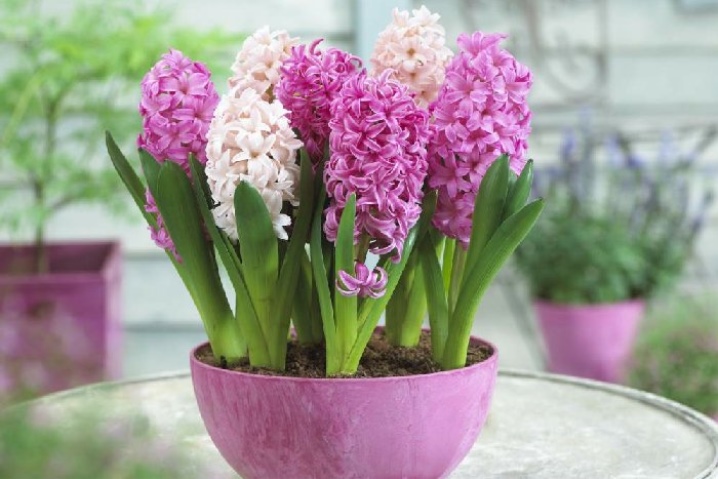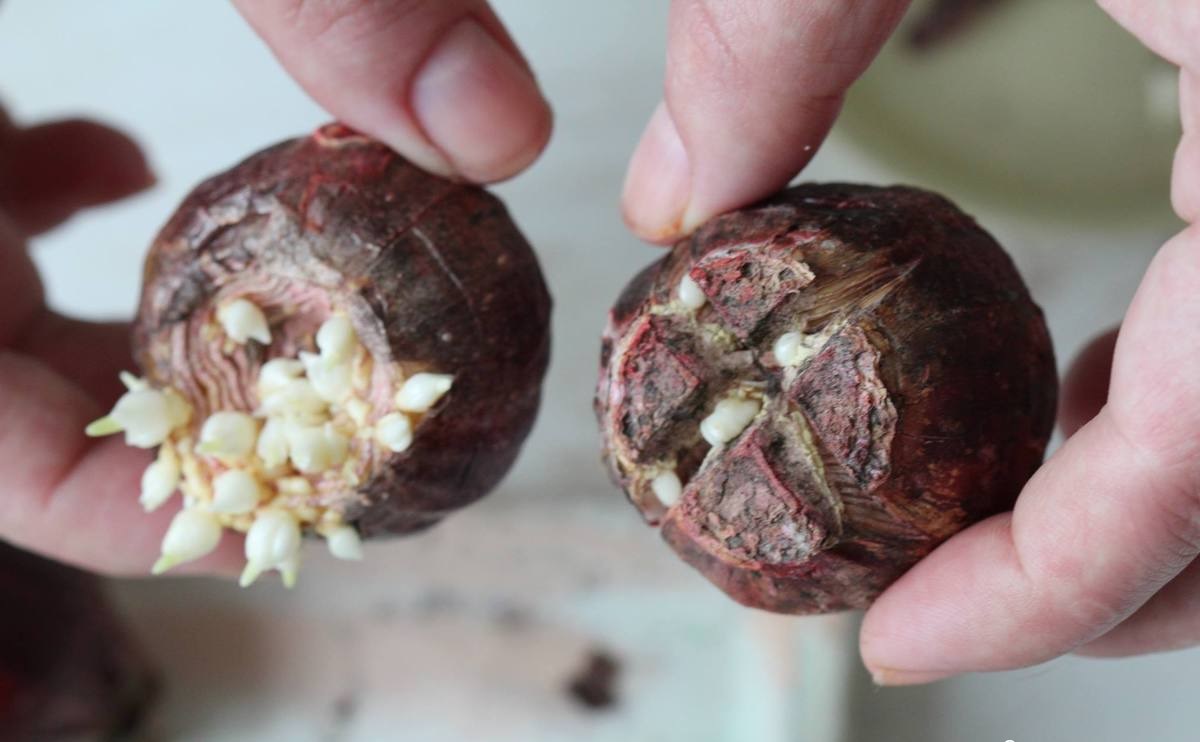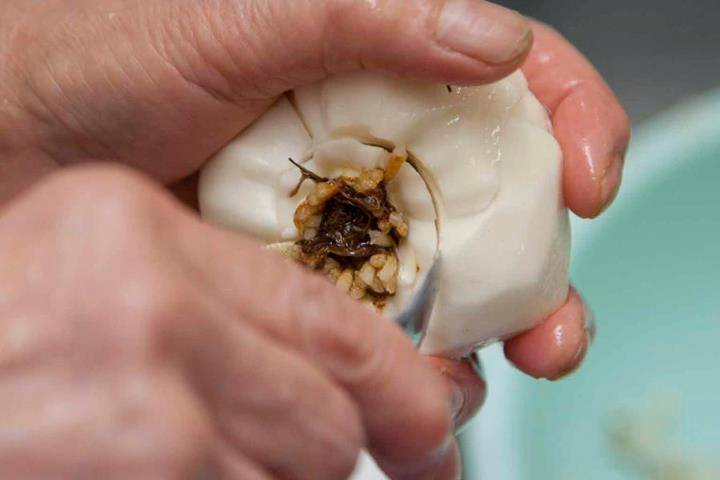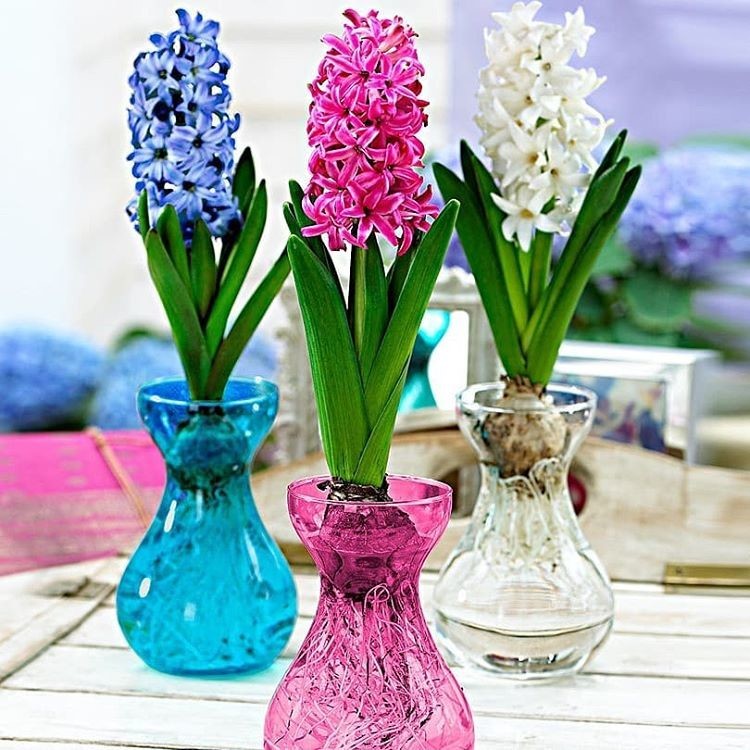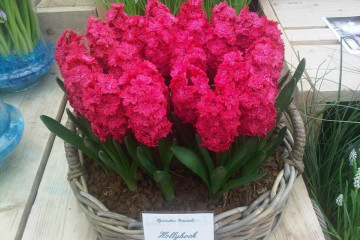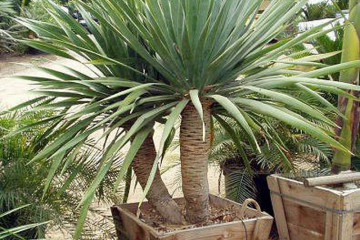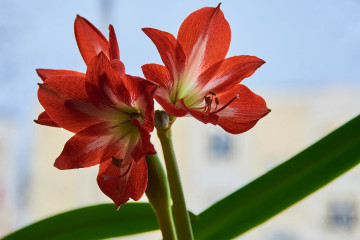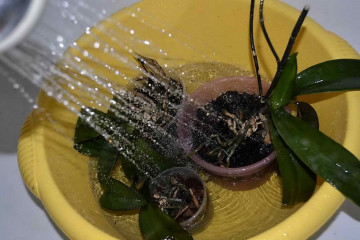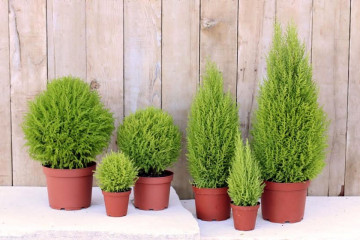Potted hyacinth: home care
Content:
Hyacinth is a genus of plants that belongs to the Asparagus family. Previously, it was included in the category of the same name, Hyacinths, and was also distinguished as a genus of the Liliaceae family. The culture is a bulbous plant that is distinguished by lush, but short-term flowering. Most often, hyacinth is purchased in the form of forcing bulbs or as an adult flowering plant. The article will discuss how hyacinth is grown in a pot, home care, reproduction, planting, treatment of diseases.
How long does hyacinth live in a pot
The lifespan of an indoor flower, regardless of the fact that it is perennial, is one season. The fact is that when forcing the plant spends a lot of nutrients, therefore, at the end of the flowering period, it needs a long rest. As soon as the hyacinth has faded, the bulb must be removed from the soil and moved to open ground. Next year, the culture will again delight with its bright flowering, but now not in a pot, but in natural growing conditions.
Reproduction methods
Hyacinths can be propagated in several ways:
- Baby bulbs;
- Seeds;
- Notching or cutting out the bottom;
- Bulbous scales;
- Leafy cuttings.
Of the above, the greatest difficulty is the question of how to grow hyacinth from seeds. The fact is that this method is used by specialists in the field of breeding work. This is the most difficult and time-consuming method, therefore it is rarely used in ordinary floriculture.
During the period of active growth and development, the mother's bulb is overgrown with children. After flowering, they usually detach easily, then they can be planted separately. If they hold on tightly, then it is better to grow the mother's bulb with the children. It will be much easier to separate them next year.
Hyacinth can be grown artificially by cutting the bottom. As a result of such manipulations, the bulb gives from 8 to 15 babies and is no longer restored. For the procedure, you will need material that has passed the resting stage and has accumulated a large amount of nutrients. The bulb must be large enough and not damaged. The material is washed, dried, the scales are separated from it, then treated with a disinfectant. Next, 4 or 2 (depending on the size of the bulb) cross-shaped incisions up to 0.6 cm deep are made with a sterile instrument. Then the bulbs are sprinkled with charcoal, dried again at a temperature of 20-22 degrees during the day. The open incisions are sprinkled with crushed coal and planted in the soil, in a dark place with the same temperature. New bulbs appear after about 3 months, then they are separated and grown for 2-3 years.
To propagate hyacinth on an industrial scale, use the method of cutting the bottom. It will allow you to get up to 40 children from a unit of planting material. This procedure is carried out at the end of the resting phase.It is very important here to cut the bottom as carefully as possible so as not to damage the bulb. For this, it is best to use a teaspoon with a sharp edge. After the operation, it is checked whether the base has been removed from all the scales, and whether the center of the bulb is not damaged. Further, the places of the cuts are treated with a fungicide, after which the material is laid out in the boxes with the cut up. Keeping the bulbs is also allowed on the wire mesh. For the fastest healing of tissues, the material should be kept at a temperature of 20-22 degrees. After a couple of months, new bulbs will appear on the scales. The parent bulb is placed in a pot in such a way that the "young" is shallow under the ground. Future hyacinths are kept in a cold greenhouse, with the onset of spring heat, they will grow, young leaves will appear. The bulbs are dug up after the end of the growing season and planted for growing. Flowering is observed after several years.
Another example of how hyacinths reproduce is with the help of bulbous scales. To do this, take an onion about 5 cm in diameter and divide it into 4-6 parts. Next, the scales are separated from the bottom and put into a plastic bag with river sand or charcoal (you can use perlite instead). The package is stored tied: six months - at a temperature of 20-25 degrees, six months - at a temperature of 17-20 degrees. Lighting should be diffused. As a result, 1-3 bulbs are formed at the base of the scales.
Propagation by leafy cuttings should be at the time of the appearance of buds. From each copy, 2 sheets are taken, cut off at the base. After treatment with a growth stimulant, they are placed in a container with sand, deepening by 3 cm.The box is covered with polyethylene and kept so under the following conditions:
- Diffused lighting;
- Air temperature - from 10 to 15 degrees;
- Humidity - 90%.
The bulbs will form in a month or a little more, in another couple of months the first roots and a leaf plate will appear. From this point on, the "young" can be moved to the garden bed. One stalk gives from 8 to 10 children.
How to prepare bulbs for planting
The first stage in growing hyacinth is the correct selection and preparation of planting material. Bulbs must be:
- Healthy;
- Clean;
- Dazed;
- Dense;
- Large enough (at least 5 cm in diameter);
- No mechanical or other damage;
- No rot.
You can prepare the bulbs yourself. This requires:
- After the death of the peduncle and foliage, the material is dug up, dried for 2 weeks at a temperature of 25-30 degrees, left for another 2 weeks, keeping the temperature at about 25 degrees, then kept in a cool place with good ventilation for 2-4 months.
- Determine the approximate start date of flowering and count back 3-4 weeks from it. This time is necessary for the growth and development of the aerial part of the flower. Then by this time add another 2.5-3 months (4-4.5 in late varieties) to cool the bulb.
- Before placing the material in the soil, it is soaked in a weak solution of potassium permanganate.
- After planting, the box with the bulbs is moved to a cool place (8-10 degrees).
- The soil is systematically moistened.
Distillation at home
This is a special agronomic procedure with the aim of deliberately removing the bulbs from dormancy and achieving the desired flowering time. Such manipulations with the plant are performed by experienced florists.In any case, no one forbids trying to drive out the culture at home.
Forcing can be done in two ways:
- Under the hood;
- In water.
In the first case, the forcing instructions include the following steps:
- Plant the bulbs in the ground. This must be done 2 months before the expected date. Each onion is placed in a separate small container or several pieces at once in one container close to each other. Fill vessels with earth mixture and tamp. Spread the bulbs over the surface.
- Cover the container with the planting material with a paper cap and transfer it to a cool (4-6 degrees) place (balcony, veranda). Keep in this form for 1 month. When the sprout appears, the temperature rises by 7-9 degrees. As soon as the buds are formed, the indicators need to be raised to 20-22 degrees.
- Bring the pot into the room. This is done when young plants reach 1-2 cm in height. The flower cannot be placed near the battery. It is protected from direct sunlight with a dark cap. Over time, the hyacinth will get used to new conditions and begin to grow actively. Then it can be moved to a permanent, sufficiently lit and well-ventilated place.
Forcing in water is even easier. To do this, take a glass or other glass container, pour stones into it, pour water on top. The bulb is set in such a way that it only slightly comes into contact with the liquid (only the roots should be in the water). The container is covered with a dark cap and the water level is monitored, adding fresh water to the glass if necessary. When the first shoots appear, the hyacinth is transplanted into a pot, mineral fertilizer is added and the plant is transferred to a warm and bright place.
Landing dates
On average, 2.5-3 months pass from planting to flowering. The moment of disembarkation depends on the type of forcing, of which there are 3:
- Early. The bulbs are planted in October and bloom at the end of December.
- Average. Planting occurs in November, flowering begins at the end of January.
- Late. The bulbs are placed in the ground in December-January, flowers appear in March-April.
Digging depth of bulbs
The bulbs are placed shallow, that is, so that 2/3 of the planting material is located above the ground.
Hyacinth care
The plant is quite unpretentious, but this does not mean that you can take care of it at random. The flower belongs to horticultural crops, therefore, when growing at home, it is necessary to create conditions for the hyacinth that are as close to natural as possible.
Watering and spraying
Hyacinth prefers well-moistened soil, but the flower does not tolerate excess water. For watering, it is recommended to use a watering can with a thin elongated spout, which will allow you to control the process so that moisture does not get on the bulb. The liquid is poured around the edges of the pot without touching the leaf axils. Water must be clean (separated, filtered, rain or melt) and at room temperature. The frequency of watering depends on the rate of drying of the land, which should always be moderately damp.
Top dressing for lush flowering
For this, mineral fertilizers are used for bulbous crops. Top dressing is applied every 2 weeks from the beginning of growth until the leaves die off after flowering. You can make your own formula. This will require:
- Sod land;
- Leafy land;
- Compost;
- Sand;
- Peat.
The components are taken in a 2: 1: 2: 1: 1 ratio and mixed thoroughly (large fragments are removed).
Peduncle pruning
After flowering, the hyacinth begins to wilt.First, the peduncle dies off, then the leaves. The first one must be removed before the ovary appears, otherwise the bulb will spend energy on the formation of seeds, which is not at all necessary at the moment. Pruning is carried out immediately after the flower is dug out of the ground. The procedure is needed in order to remove excess tissue. Various pests or parasites may remain on them, which will not allow the bulb to be preserved during the dormant period. The stem is cut completely, leaving only a small stump.
Temperature regime
The plant feels comfortable at a temperature of 20-22 degrees.
Lighting and supplementary lighting
In poor light, hyacinth is unable to bloom. At home, you need to provide the plant with 12-hour daylight hours. In winter, it is better to use an additional light source.
Newly planted bulbs are kept in a dark place for 6-8 weeks to promote better root development. When the sprouts reach a height of 2-2.5 cm, the hyacinth is transferred to a semi-shaded place. When buds appear, the flower is placed in a brightly lit space (direct sunlight should fall on it only in the morning and evening). At the end of flowering, the pot is transferred to a place where direct sunlight does not fall. After the foliage withers, the illumination does not matter, the bulbs are removed to a dark place.
During bud formation
In the first half of spring, when hyacinth is actively growing and preparations are underway for flowering, the following conditions must be met:
- Immediately after planting - complete darkness for 4-6 weeks. When the sprouts stretch up to 3-5 cm, partial shade.
- High humidity.
- Air temperature - 5 degrees (no more) for 1-1.5 months.
In the second half of spring and during the flowering period:
- When the peduncle with buds has just appeared, the lighting should be intense and prolonged, but without access to direct sunlight.
- When the buds are formed, you need to switch to moderate watering.
- The air temperature is about 12 degrees (during the growth of shoots), 20-22 degrees (during the flowering period). Sudden changes in temperature must not be allowed. Hyacinth must be protected from drafts.
In the summer, when the flower accumulates strength:
- Lighting should be diffused;
- Watering is moderate;
- The air temperature varies from 18 to 20 degrees.
During the rest period
In the fall, preparations are made for winter. Flower care must meet the following requirements:
- When the leaves dry naturally, the bulbs are dug up, peeled and dried;
- Humidity is moderate;
- The temperature is within 15-20 degrees.
During wintering, lighting is not important as the bulbs are stored outdoors in a dark room. Humidity should be moderate; temperatures range from 15 to 20 degrees.
Common growing problems
When growing hyacinth, the following problems may arise:
- Too slow growth of the peduncle, the disclosure of flowers in a leaf rosette;
- Yellowing of the leaves;
- The buds fall off before they can open;
- Flowers do not form;
- Flowers are deformed;
- Leaves are elongated, drooping;
- Decay of the bulb;
- When planted together, bulbs bloom at different times;
- Leaves and stems fall out of the bulb.
Diseases and pests
Among the common ailments and parasites that pose a danger to hyacinth are the following:
- Fusarium (fungal disease). It manifests itself in the fact that the stems and leaves begin to wilt. A characteristic feature is the presence of mucus on the surface of the bulb. It is impossible to cure a neglected disease. With minor damage, all affected parts of the plant are removed, the cut sites and the bulb are treated with sulfur or activated carbon. The plant should be kept separate from other house flowers.
- Bacterial rot. Symptoms are the appearance of black spots on the leaves and mucous plaque on the bulb. The disease does not respond to treatment. The affected hyacinth is destroyed, the pot is treated with a disinfectant, and the soil is thrown away. Before planting again, the bulbs are recommended to be treated with a phosphorus-containing substance.
- Aphid. It is characterized by yellowing of the leaves. Colonies of parasites can be seen on the tissues of the flower. To rid the plant of pests, you need to treat it with insecticides, for example, Aktellik.
- Stem nematodes.
Signs:
- Change in the shape of leaves and peduncles;
- The appearance of thickening;
- The affected areas turn pale, then turn brown;
- Sick areas die off.
The diseased hyacinth is destroyed (burned). The bulbs can be left, but before replanting the hyacinth, they must be immersed in hot (45 degrees) water for 15 minutes, then rinsed and dried.
Root mite. The parasite eats the bulb, as a result of which it falls apart, leaving only dust inside. Treatment is with an insecticide (eg Apollo). Prevention - do not allow the bulb to become waterlogged.
Care errors, their elimination
The most common mistakes in growing hyacinth are:
- Improper watering;
- Lack of watering;
- Short rest period. As a result, the peduncle practically does not grow, and the flowers appear in a leaf rosette;
- The presence of drafts;
- Improper watering. Causes the leaves to turn yellow.
- Poor watering, in which water gets on the buds. Consequence - the buds do not open and quickly fade;
- Planting small bulbs;
- Short rest period;
- Wintering took place at high temperatures;
- Lack of moisture;
- Bulbs of different sizes.
- Uneven lighting. The result is that the bulbs in the same container bloom at different times.
- Overdried soil.
- Waterlogging. Consequence - flowers and peduncles are separated from the bulb.
These factors explain why hyacinth does not bloom:
- Improper wintering (non-observance of temperature and light conditions) is the cause of deformation of flowers.
- Lack of light, which leads to stretching of the leaves.
- Excess moisture causes the bulbs to rot.
Hyacinth is a very beautiful and not too demanding plant in terms of care. Despite the fact that the culture is intended primarily for growing in gardens, hyacinth is also quite successfully bred at home.
Video
